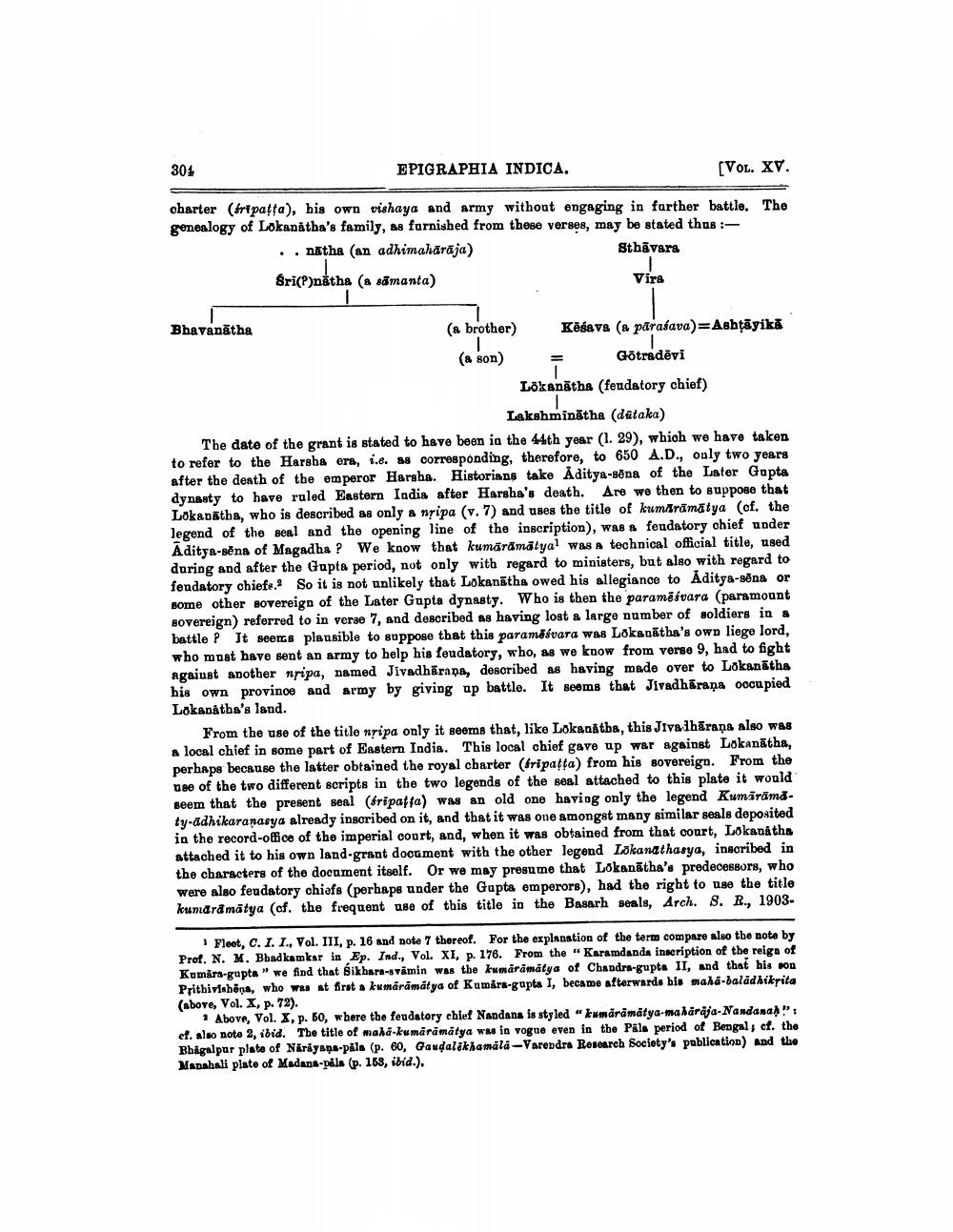________________
301
EPIGRAPHIA INDICA.
[VOL. XV.
charter (ripaṭṭa), his own vishaya and army without engaging in further battle. The genealogy of Lokanatha's family, as furnished from these verses, may be stated thus :.. natha (an adhimahārāja)
Sri(?)natha (a samanta)
Bhavanatha
(a brother) I (a son)
Sthāvara I Vira
Kesava (a parasava)=Ashṭāyikā
T Gōtradevi
Lokanatha (feudatory chief)
T
Lakshminätha (dütaka)
The date of the grant is stated to have been in the 44th year (1. 29), which we have taken to refer to the Harsha era, i.e. as corresponding, therefore, to 650 A.D., only two years after the death of the emperor Harsha. Historians take Aditya-sona of the Later Gupta Are we then to suppose that dynasty to have ruled Eastern India after Harsha's death. Lokanatha, who is described as only a nṛipa (v. 7) and uses the title of kumaramatya (cf. the legend of the seal and the opening line of the inscription), was a feudatory chief under Aditya-sena of Magadha ? We know that kumaramatyal was a technical official title, used during and after the Gupta period, not only with regard to ministers, but also with regard to fendatory chiefe. So it is not unlikely that Lokanatha owed his allegiance to Aditya-sona or some other sovereign of the Later Gupta dynasty. Who is then the paramesvara (paramount Sovereign) referred to in verse 7, and described as having lost a large number of soldiers in a battle? It seems plausible to suppose that this parametvara was Lokanatha's own liege lord, who must have sent an army to help his feudatory, who, as we know from verse 9, had to fight against another nripa, named Jivadharana, described as having made over to Lokanatha his own province and army by giving up battle. It seems that Jivadharana occupied Lokanatha's land.
From the use of the title nṛipa only it seems that, like Lokanatha, this Jivadharana also was a local chief in some part of Eastern India. This local chief gave up war against Lokanatha, perhaps because the latter obtained the royal charter (fripaṭṭa) from his sovereign. From the use of the two different scripts in the two legends of the seal attached to this plate it would seem that the present seal (éripatta) was an old one having only the legend Kumārāmāty-adhikaraṇasya already inscribed on it, and that it was one amongst many similar seals deposited in the record-office of the imperial court, and, when it was obtained from that court, Lokanatha attached it to his own land-grant document with the other legend Lokanathasya, inscribed in the characters of the document itself. Or we may presume that Lokanatha's predecessors, who were also feudatory chiefs (perhaps under the Gupta emperors), had the right to use the title kumaramatya (cf. the frequent use of this title in the Basarh seals, Arch. S. R., 1903
1 Fleet, C. I. I., Vol. III, p. 16 and note 7 thereof. For the explanation of the term compare also the note by Prof. N. M. Bhadkamkar in Ep. Ind., Vol. XI, p. 176. From the "Karamdanda inscription of the reign of Kumara-gupta" we find that Sikhara-svamin was the kumaramatya of Chandra-gupta II, and that his son Prithivishena, who was at first a kumārāmätya of Kumara-gupta I, became afterwards his maha-baladhikrita (above, Vol. X, p. 72).
Above, Vol. X, p. 50, where the feudatory chief Nandana is styled "kumärämätya-mahārāja-Nandanaḥ": ef. also note 2, ibid. The title of mahā-kumārāmātya was in vogue even in the Pala period of Bengal; cf. the Bhagalpur plate of Narayana-pala (p. 60, Gaudalikhamälä-Varendra Research Society's publication) and the Manahali plate of Madana-pala (p. 158, ibid.).




